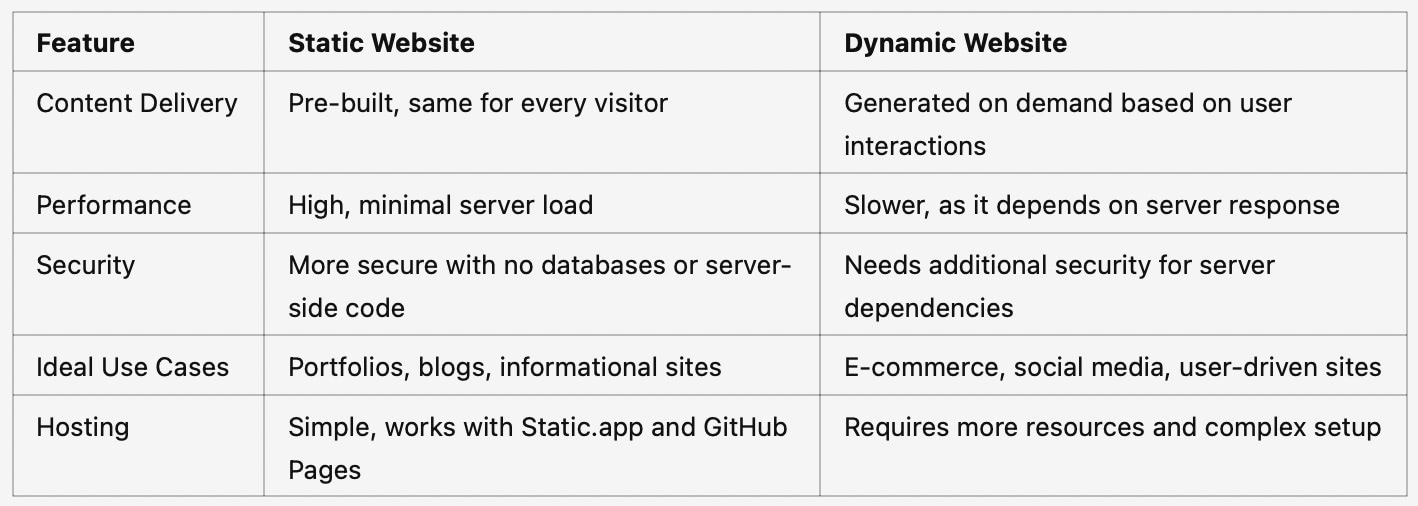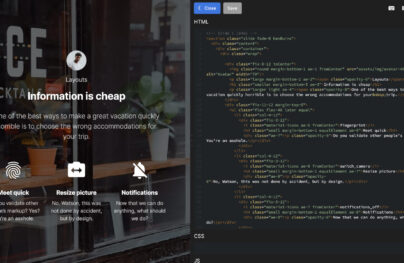What is a Static Website and How to Make One
Static websites are becoming popular among businesses, creators, and developers who seek fast, secure, and low-maintenance options for their online presence. Whether launching a portfolio, a business site, or a landing page, understanding static websites and their advantages can help make the best choice for any project.
Here’s a detailed guide covering static websites, their benefits, limitations, and advanced techniques for building powerful static sites.
What is a Static Website?
A static website is made with pre-rendered HTML, CSS, and JavaScript files. Unlike dynamic websites, which generate content on demand using databases and server-side code, static websites serve the same content to every visitor. This simplicity results in faster load times, better security, and reduced hosting costs, making static sites a great choice for various applications.

Slides – Static Website Builder
How Static Websites Work
Static websites serve content directly from HTML files on the server to the user’s browser without involving databases or back-end processing. Any interactivity is achieved through client-side scripting, usually with JavaScript, creating a straightforward, reliable user experience.
Pro Tip for Developers: Projects requiring interactive features can still include JavaScript frameworks like React or Vue, or integrate forms that send data to external services, such as Airtable.
With Postcards Email Builder you can create and edit email templates online without any coding skills! Includes more than 100 components to help you create custom emails templates faster than ever before.
Free Email BuilderFree Email TemplatesCommon Uses for Static Websites
Static websites work best when content doesn’t require frequent updates.
- Portfolios: Showcase personal or professional work without much maintenance.
- Blogs: Created with static site generators (SSGs) like Jekyll or Hugo.
- Landing Pages: For marketing campaigns where speed and reliability are essential.
- Documentation and Informational Sites: Perfect for reference materials that don’t need real-time updates.
- Small Business or Personal Websites: Sites that benefit from the speed and security of static architecture.
Advantages of Static Websites
Speed and Performance
Static websites load extremely quickly with pre-built files served directly to users, improving both user experience and SEO.
Cost-Effectiveness
Static sites require minimal resources to host. Many static hosting platforms, such as GitHub Pages and Static.app, even offer free plans.
Security
Since they lack server-side code and databases, static websites have fewer vulnerabilities and are less prone to attacks.
Scalability
With Startup App and Slides App you can build unlimited websites using the online website editor which includes ready-made designed and coded elements, templates and themes.
Try Startup App Try Slides AppOther ProductsStatic sites can easily handle high traffic by serving pre-built files, especially when using a Content Delivery Network (CDN) to deliver content globally.
Reliability
With no server-side dependencies, static sites have fewer points of failure, ensuring consistent uptime.
Pro Tip for Developers: Use a CDN for global reach and improved speed. Hosting providers like Netlify and Static.app offer built-in CDN support for fast, reliable delivery.
Limitations of Static Websites
While powerful, static websites may not be suitable for every project.
Limited Interactivity
Static sites aren’t ideal for real-time updates or personalization without complex workarounds, making them less suitable for applications that require user accounts or frequent data changes.
Maintenance Complexity
Updating static sites can be challenging unless using a static site generator. For large sites, managing individual HTML files may become difficult.
Limited Functionality
Features like user authentication, content management, and complex data handling are better suited for dynamic websites.
Pro Tip for Developers: If you plan to update content frequently, consider using a static site generator (SSG). SSGs allow for templates and more efficient content management.
Static vs. Dynamic Websites

In terms of content delivery, a static website provides pre-built content that is the same for every visitor. In contrast, a dynamic website generates content on demand based on user interactions. Performance-wise, static websites offer high efficiency with minimal server load, while dynamic sites tend to be slower as they depend on server responsiveness.
Regarding security, static websites are generally more secure due to the absence of databases or server-side code, while dynamic websites require additional security measures to protect server dependencies. Static websites are ideal for portfolios, blogs, and informational sites, while dynamic sites are better suited for applications like e-commerce, social media, and other user-driven sites.
In terms of hosting, static websites benefit from more straightforward hosting solutions compatible with platforms like Static hosting and GitHub Pages, whereas dynamic websites demand more resources and a more complex server setup.

Static.app – Static Website Hosting
What Are Some Advantages of Using Dynamic Websites for Content-Heavy Sites?
Dynamic websites offer a range of benefits for managing large volumes of content efficiently. Here are some key advantages:
Enhanced Content Management
- Scalability: Dynamic websites are equipped to handle substantial amounts of material. This makes them ideal for projects like directories with thousands or even millions of entries.
- Automation: These platforms can automate updates and changes across the site, saving time and reducing the need for manual edits.
Improved User Experience
- Personalization: Dynamic websites can tailor content to individual users based on their preferences or past interactions, providing a more engaging browsing experience.
- Interactive Features: With the capability to incorporate elements like real-time data updates or user-generated content, dynamic sites often offer more interactivity.
Flexible Design and Structure
- Template Use: Dynamic sites allow for templates, ensuring consistency while making it easier to update and redesign.
- Database Integration: They facilitate seamless integration with databases, which is crucial for sites that require frequent data updates or complex data structures.
Overall, dynamic websites offer robust solutions for sites aiming to manage expansive and evolving content while enhancing user engagement efficiently.
Understanding Dynamic Websites: Content Updates and Personalization Explained
Dynamic websites are a versatile solution for delivering personalized content and seamless updates. But how exactly do they manage content updates and tailor user experiences?
Server-Side Functionality
Dynamic websites operate with server-side processing, often utilizing scripting languages like PHP or Python. When a user visits, the server executes specific code or interacts with a database to deliver a customized page.
Real-Time Personalization
One of the key strengths of dynamic sites is their ability to personalize content. For instance, a logged-in user may receive a unique page version, displaying personalized greetings or relevant information, while another visitor sees general content. This variation is possible because the server constructs each page view based on user-specific data or session status.
Immediate Content Updates
Changes made in a website’s management interface—often through Content Management Systems (CMS) like WordPress or Joomla—are instantly reflected on the site. This is due to the dynamic nature: once a change is saved, the system automatically serves the most current version to visitors. There’s no need for manual updates to static code, significantly easing the process of keeping a site fresh.
Benefits of Dynamic Architecture
- Responsive Design: With dynamic systems, websites can easily adapt to various device types and screen sizes.
- Efficient Content Management: Administrators can update the site without extensive programming knowledge.
- Scalability: Such websites can handle growing amounts of data and increasingly complex user requirements with minimal adjustments.
By leveraging server-side scripting and databases, dynamic websites effectively manage real-time updates and personalization, ensuring users receive relevant and updated content on every visit.
Static Website Generators: A Modern Solution
Static website generators (SSGs) like Jekyll, Hugo, and Gatsby have made building static websites easier, especially for content-heavy projects.
- Jekyll: Ideal for blogs and documentation.
- Hugo: Known for its speed and ease of use.
- Gatsby and Next.js: Great for React-based development, supporting static and dynamic rendering.
Pro Tip for Developers: For a professional, code-free design, consider using Slides by Designmodo to create polished, responsive static sites quickly, especially for landing pages or portfolios.
Hosting Options for Static Websites
Static sites benefit from simplified hosting with various platforms offering built-in features for deployment and CDN support:
- Static.app: Dedicated to static websites with privacy-focused analytics and CDN support for high-speed delivery.
- GitHub Pages: Ideal for personal or documentation sites, especially for GitHub-hosted projects.
- Netlify: Provides free hosting, continuous deployment, and built-in CDN.
- Vercel: Great for frameworks like Next.js, supporting static and dynamic content.
- Amazon S3: With CloudFront, it’s perfect for high-traffic sites needing global reach.
Resource Recommendation: Try Static.app for developer-focused hosting with built-in analytics and CDN capabilities, making deployment simple and efficient.
When to Choose a Static Website
Static websites are ideal if you prioritize speed, security, and simplicity without frequent updates or interactive features. Best projects for static sites include:
- Portfolios and Personal Sites: Minimal updates with fast loading times.
- Landing Pages: Speed is crucial for user engagement on marketing pages.
- Documentation Sites: Reliable and easy to update as needed.
Advanced Techniques and Tools for Developers
Optimizing Performance for Static Sites
- Image Optimization: Use responsive images with srcset and compress them using tools like TinyPNG or Squoosh. For better compression, consider using WebP.
- CSS/JS Minification: Use CSSNano and Terser to remove unnecessary characters, reducing file sizes. HTML can be streamlined with HTMLMinifier.
- GZIP/Brotli Compression: Ensure hosting supports GZIP or Brotli for file compression, speeding up delivery.
SEO for Static Websites
- Meta Tags and Structured Data: Use optimized meta tags and structured data (e.g., JSON-LD) to improve search visibility.
- Sitemap and Robots.txt: Generate an XML sitemap with tools like xml-sitemap-generator, and use robots.txt to focus crawlers on priority pages.
- Lazy Loading: Add loading=”lazy” to defer loading off-screen images, speeding up initial load times.
Automating Development and Deployment
- Static Site Generators: Choose a generator suited to your project. Gatsby is ideal for React, while Jekyll and Hugo work well for content sites.
- Automated Deployments: Connect your repository with Netlify or Vercel for continuous deployment, where changes pushed to the main branch automatically deploy.
- Build Tools: Webpack and Parcel support code splitting, bundling, and optimization, which improves load times.
Adding Dynamic Functionality
While static websites don’t inherently support server-side functions, you can integrate dynamic features:
- APIs: Use APIs to fetch and display real-time data, like weather or news feeds.
- Headless CMS: Platforms like Contentful and Sanity allow you to manage content without server-side dependencies. Use the CMS API to feed data during build time or at runtime.
- Serverless Functions: Available on platforms like Netlify and Vercel, serverless functions enable features like form submissions or API interactions without a traditional server.
Conclusion
Static websites offer unmatched speed, security, and scalability. With the right tools and techniques, developers can achieve sophisticated functionality without server-side dependencies. From optimizing performance and automating workflows to integrating dynamic features, static websites provide a robust, modern solution for projects prioritizing simplicity, speed, and security.
Hosting solutions like Static.app and design tools like Slides by Designmodo make building and deploying static websites more efficient, powerful, and visually appealing. For developers, static sites present an opportunity to balance simplicity with performance, meeting the demands of today’s fast-paced digital landscape.







